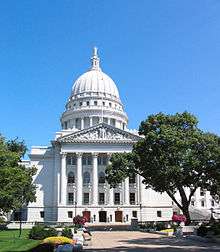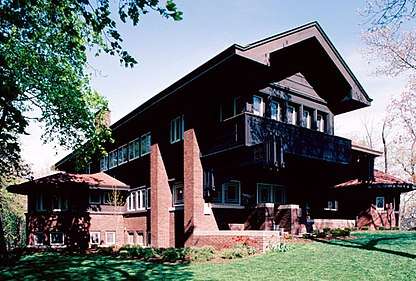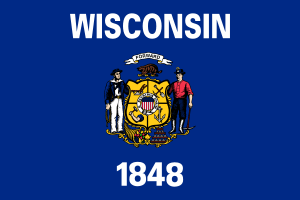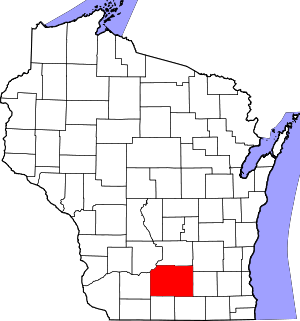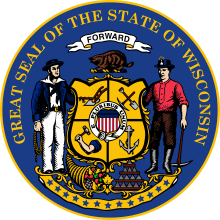Madison, Wisconsin
Madison is the capital of the U.S. state of Wisconsin and the seat of Dane County. As of July 1, 2019, Madison's estimated population of 259,680[3] made it the second-largest city in Wisconsin by population, after Milwaukee, and the 81st-largest in the United States. Madison is the fastest-growing city in Wisconsin.[5] The city forms the core of the Madison Metropolitan Area which includes Dane County and neighboring Iowa, Green, and Columbia counties for a population of 654,230.
Madison, Wisconsin | |
|---|---|
State capital and city | |
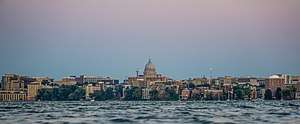 A view of the skyline of the Madison Isthmus and Lake Mendota from Picnic Point | |
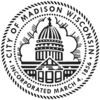 Seal 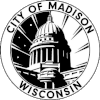 Logo | |
| Nickname(s): Madtown, Mad City, "The City of Four Lakes" | |
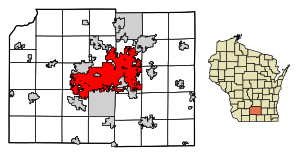 Location of Madison in Dane County, Wisconsin. | |
 Madison, Wisconsin Location in Wisconsin, United States & North America  Madison, Wisconsin Madison, Wisconsin (the United States) 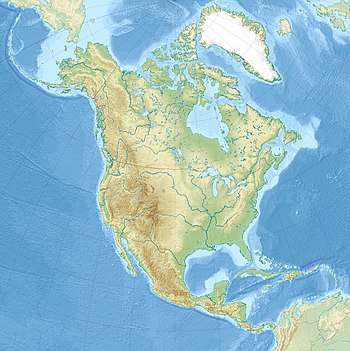 Madison, Wisconsin Madison, Wisconsin (North America) | |
| Coordinates: 43°04′29″N 89°23′03″W | |
| Country | United States |
| State | Wisconsin |
| County | Dane |
| Municipality | City |
| Founded | 1836 |
| Chartered | 1846 |
| Incorporated | 1856 |
| Named for | James Madison |
| Government | |
| • Mayor | Satya Rhodes-Conway (D) |
| • Body | Madison Common Council |
| Area | |
| • City | 101.53 sq mi (262.96 km2) |
| • Land | 79.57 sq mi (206.09 km2) |
| • Water | 21.96 sq mi (56.88 km2) |
| Elevation | 873 ft (226 m) |
| Population | |
| • City | 233,209 |
| • Estimate (2019)[3] | 259,680 |
| • Rank | US: 82nd WI: 2nd |
| • Density | 3,263.50/sq mi (1,260.05/km2) |
| • Urban | 401,661 1 (US: 93rd) |
| • Metro | 654,230 (US: 86th) |
| • CSA | 880,520 (US: 61st) |
| • Demonym | Madisonian |
| Time zone | UTC−6 (Central) |
| • Summer (DST) | UTC−5 (CDT) |
| Zip Codes | ZIP Codes[4]
|
| Area code | 608 |
| FIPS code | 55-48000 |
| GNIS feature ID | 1581834 |
| Website | cityofmadison |
| 1 Urban = 2010 Census | |
Located on an isthmus and lands surrounding four lakes–Lake Mendota, Lake Monona, Lake Kegonsa and Lake Waubesa–the city is home to the University of Wisconsin–Madison, the Wisconsin State Capitol, Henry Vilas Zoo, lakes, and an extensive network of parks and bike trails. Madison has historically been a center for progressive political activity, protests, and demonstrations. The presence of the University of Wisconsin–Madison (the largest employer in the state) as well as other educational institutions has a significant impact on the economy, culture, and demographics of Madison.[6][7][8][9][10]
Madison is a growing technology economy, and the region is home to the headquarters of Epic Systems, American Family Insurance, Exact Sciences, Promega, American Girl, Sub-Zero, Lands' End, a regional office for Google, and the University Research Park,[11][12][13] as well as many biotech and health systems startups. A 2018 report ranked Madison 14th among the top fifteen cities worldwide for venture capital deals per capita.[14]
Madison, which is named for American Founding Father and President James Madison, is home to eight National Historic Landmarks, including one UNESCO World Heritage Site.[15]
History
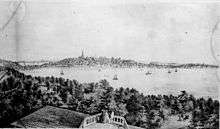
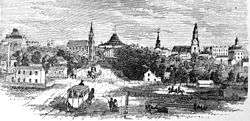
Pre-colonization
Before Europeans, humans inhabited the area in and around Madison for about 12,000 years.[16] In 1800, the Madison area was Ho-Chunk (Winnebago) Country. The Native Americans called this place Taychopera (Ta-ko-per-ah), meaning "land of the four lakes" (Mendota, Monona, Waubesa, and Kegonsa). Effigy mounds, which had been constructed for ceremonial and burial purposes over 1,000 years earlier, dotted the rich prairies around the lakes.[17]
Creation
Madison's European origins begin in 1829, when former federal judge James Duane Doty purchased over a thousand acres (4 km²) of swamp and forest land on the isthmus between Lakes Mendota and Monona, with the intention of building a city in the Four Lakes region. He purchased 1,261 acres for $1,500. When the Wisconsin Territory was created in 1836 the territorial legislature convened in Belmont, Wisconsin. One of the legislature's tasks was to select a permanent location for the territory's capital. Doty lobbied aggressively for Madison as the new capital, offering buffalo robes to the freezing legislators and promising choice Madison lots at discount prices to undecided voters.[18] He had James Slaughter plat two cities in the area, Madison and "The City of Four Lakes", near present-day Middleton.
Doty named his city Madison for James Madison, the fourth President of the U.S. who had died on June 28, 1836, and he named the streets for the other 39 signers of the U.S. Constitution.[19] Although the city existed only on paper, the territorial legislature voted on November 28, 1836 in favor of Madison as its capital, largely because of its location halfway between the new and growing cities around Milwaukee in the east and the long established strategic post of Prairie du Chien in the west, and between the highly populated lead mining regions in the southwest and Wisconsin's oldest city, Green Bay, in the northeast.[20][21]
Expansion
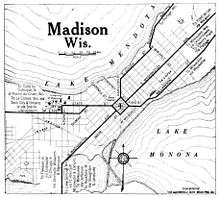
The cornerstone for the Wisconsin capitol was laid in 1837, and the legislature first met there in 1838. On October 9, 1839, Kintzing Prichett registered the plat of Madison at the registrar's office of the then-territorial Dane County.[22] Madison was incorporated as a village in 1846, with a population of 626. When Wisconsin became a state in 1848, Madison remained the capital, and the following year it became the site of the University of Wisconsin (now University of Wisconsin–Madison). The Milwaukee & Mississippi Railroad (a predecessor of the Milwaukee Road) connected to Madison in 1854. Madison incorporated as a city in 1856, with a population of 6,863, leaving the unincorporated remainder as a separate Town of Madison.[23] The original capitol was replaced in 1863 and the second capitol burned in 1904. The current capitol was built between 1906 and 1917.[24]
During the Civil War, Madison served as a center of the Union Army in Wisconsin. The intersection of Milwaukee, East Washington, Winnebago, and North Streets is known as Union Corners, because a tavern there was the last stop for Union soldiers before heading to fight the Confederates. Camp Randall, on the west side of Madison, was built and used as a training camp, a military hospital, and a prison camp for captured Confederate soldiers. After the war ended, the Camp Randall site was absorbed into the University of Wisconsin and Camp Randall Stadium was built there in 1917. In 2004 the last vestige of active military training on the site was removed when the stadium renovation replaced a firing range used for ROTC training.
1960s and 1970s
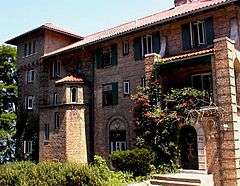
In the 1960s and 1970s, the Madison counterculture was centered in the neighborhood of Mifflin and Bassett streets, referred to as "Miffland". The area contained many three-story apartments where students and counterculture youth lived, painted murals, and operated the co-operative grocery store, the Mifflin Street Co-op. Residents of the neighborhood often came into conflict with authorities, particularly during the administration of Republican mayor Bill Dyke. Dyke was viewed by students as a direct antagonist in efforts to protest the Vietnam War because of his efforts to suppress local protests. The annual Mifflin Street Block Party became a focal point for protest, although by the late 1970s it had become a mainstream community party.
During the late 1960s and early 1970s, thousands of students and other citizens took part in anti-Vietnam War marches and demonstrations, with more violent incidents drawing national attention to the city and UW campus. These include:
- the 1967 student protest of Dow Chemical Company, with 74 injured;
- the 1969 strike to secure greater representation and rights for African-American students and faculty, which resulted in the involvement of the Wisconsin Army National Guard;
- the 1970 fire that caused damage to the Army ROTC headquarters housed in the University of Wisconsin Armory and Gymnasium, also known as the Red Gym; and
- the 1970 late-summer predawn ANFO bombing of the Army Mathematics Research Center in Sterling Hall, killing a postdoctoral researcher, Robert Fassnacht. (See Sterling Hall bombing)
These protests were the subject of the 1979 documentary The War at Home.[25] David Maraniss's 2004 book, They Marched into Sunlight, incorporated the 1967 Dow protests into a larger Vietnam War narrative. Tom Bates wrote the book Rads on the subject (ISBN 0-06-092428-4). Bates wrote that Dyke's attempt to suppress the annual Mifflin Street Block Party "would take three days, require hundreds of officers on overtime pay, and engulf the student community from the nearby Southeast Dorms to Langdon Street's fraternity row. Tear gas hung like heavy fog across the Isthmus." In the fracas, student activist Paul Soglin, then a city alderman, was arrested twice and taken to jail. Soglin was later elected mayor of Madison, serving several times.
21st century
In early 2011, Madison was the site for large protests against a bill proposed by Governor Scott Walker that abolished almost all collective bargaining for public worker unions.[26] The protests at the capitol ranged in size from 10,000 to over 100,000 people and lasted for several months.[27]
Geography
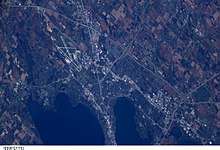
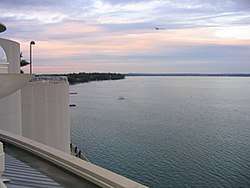
Madison is located in the center of Dane County in south-central Wisconsin, 77 miles (124 km) west of Milwaukee and 122 miles (196 km) northwest of Chicago. The city completely surrounds the smaller town of Madison, the city of Monona, and the villages of Maple Bluff and Shorewood Hills. Madison shares borders with its largest suburb, Sun Prairie, and three other suburbs, Middleton, McFarland, and Fitchburg. Other suburbs include the city of Verona and the villages of Cottage Grove, DeForest, and Waunakee as well as Mount Horeb, Oregon, Stoughton, and Cross Plains.
According to the United States Census Bureau, the city has a total area of 94.03 square miles (243.54 km2), of which 76.79 square miles (198.89 km2) is land and 17.24 square miles (44.65 km2) is water.[28]
The city is sometimes described as The City of Four Lakes, comprising the four successive lakes of the Yahara River: Lake Mendota ("Fourth Lake"), Lake Monona ("Third Lake"), Lake Waubesa ("Second Lake") and Lake Kegonsa ("First Lake"),[29] although Waubesa and Kegonsa are not actually in Madison, but just south of it. A fifth smaller lake, Lake Wingra, is within the city as well; it is connected to the Yahara River chain by Wingra Creek. The Yahara flows into the Rock River, which flows into the Mississippi River. Downtown Madison is located on an isthmus between Lakes Mendota and Monona. The city's trademark of "Lake, City, Lake" reflects this geography.
Neighborhoods
Local identity varies throughout Madison, with over 120 officially recognized neighborhood associations, such as the east side Williamson-Marquette Neighborhood.[30][31] Historically, the north, east, and south sides were blue collar while the west side was white collar, and to a certain extent this remains true. Students dominate on the University of Wisconsin campus and to the east into downtown, while to its south and in Shorewood Hills on its west, faculty have been a major presence since those neighborhoods were originally developed. The turning point in Madison's development was the university's 1954 decision to develop its experimental farm on the western edge of town; since then, the city has grown substantially along suburban lines.
Major commercial areas
Hilldale
The Hilldale area comprises the Hill Farms neighborhood, Sunset Village Neighborhood, and part of the suburb of Shorewood Hills. The area has long winding streets, and according to a planning document issued by the neighborhood association, a "suburban-like feel".[32] The area is also a commercial district, and contains Hilldale Shopping Center, an outdoor shopping center containing restaurants, a movie theater, and national retail chains.
Capitol Square
The Capitol Square Area is Madison's central business district. It is home to high rise apartments, restaurants, and shopping outlets. It contains several museums and is home to the Wisconsin State Capitol building and the Monona Terrace.[33] The capitol square holds a number of public events for the city of Madison including the Dane County Farmers' Market, Concerts on the Square, Taste of Madison and Art Fair on the Square. The area's nightlife is served by several bars and live music venues.[34]
State Street
State Street, which links the University of Wisconsin campus with the Capitol Square, is lined with restaurants, espresso cafes, and shops. Only pedestrians, buses, emergency vehicles, delivery vehicles, and bikes are allowed on State Street. State Street is home to much of the nightlife of the University of Wisconsin-Madison, as it is the location of a number of bars and performance venues ranging from comedy clubs to multiple large theaters, including the historic Orpheum Theater, that feature local ballets and Broadway touring casts. State street is also home to Freakfest, the annual Halloween party in Madison.
Park Street
The Park Street Area is located in the south of Madison, and contains multiple official neighborhoods, including the Burr Oaks Neighborhood Association and Greenbush. It has been described as the "racially and economically diverse area of Madison".[35] Park Street is home to ethnic restaurants and specialty grocery stores, as well as retail. Residential areas to the sides of Park Street tend to have smaller houses or condos, and a higher density of houses.
Monroe Street
The Dudgeon-Monroe neighborhood neighbors downtown Madison. It is located around Monroe Street, a commercial area which has local shops, coffee houses, dining and galleries.[36] It is home to a neighborhood jazz fest and Wingra Park, where people can rent paddle boats and canoes at the boathouse on Lake Wingra.
Willy Street
The Marquette neighborhood sits on the near east side of Madison. Willy (Williamson) Street contains locally owned shops, restaurants, and entertainment establishments, as well as art galleries, and the Willy Street Co-op. The houses in the Marquette neighborhood fall into two separate historic districts, Third Lake Ridge Historic District and Marquette Bungalow Historic District.[37] The area is also the location of festivals like the Waterfront Festival (June), La Fete de Marquette (July), Orton Park Festival (August), and Willy Street Fair (September). The Willy Street neighborhood is a hub for Madison's bohemian culture. Houses lining the street are often painted colorfully, and the area has several murals.[38]
Architecture
.jpg)

Madison's architectural landmarks reflect a wide range of styles, from the densest cluster of Native American effigy mounds in the United States to the Beaux-Arts Wisconsin State Capitol, the Renaissance Revival University of Wisconsin Memorial Union and the Overture Center for the Arts, designed by postmodern architect César Pelli. Madison is home to eight buildings designed by influential Wisconsin-born modern architect Frank Lloyd Wright, more than any other city outside of the Chicago metropolitan area. Wright was based at Taliesin in nearby Spring Green for most of his career, and his designs in Madison include Monona Terrace, the city's lakefront convention center, as well as Wright's first Usonian house, the Herbert and Katherine Jacobs First House, which is a UNESCO World Heritage Site.[39][40][15]
The height of Madison's skyline is limited by a state law that restricts building heights in the downtown area. All buildings within one mile (1.6 km) of the Wisconsin State Capitol have to be less than 1,032.8 feet (314.8 m) above sea level to preserve the view of the building in most areas of the city.[41] The Wisconsin State Capitol dome was modeled after the dome of the U.S. Capitol, and was erected on the high point of the isthmus. Capitol Square is located in Madison's urban core.
The architect Frank Lloyd Wright spent much of his childhood in Madison and studied briefly at the university. Wright designed 32 buildings for the Madison area, of which 12 were constructed. Nine of the twelve buildings still stand today. Buildings in Madison designed by Wright include Usonian House, and the Unitarian Meeting House. Monona Terrace, now a convention and community center overlooking Lake Monona, was created by Anthony Puttnam—a student of Wright's—based on a 1957 Wright design. The Harold C. Bradley House in the University Heights neighborhood was designed collaboratively by Louis H. Sullivan and George Grant Elmslie in 1908–1910, and now serves as the Sigma Phi Fraternity.
The Overture Center for the Arts, opened 2004, and the adjacent Madison Museum of Contemporary Art, opened 2006, on State Street near the capitol were designed by architect César Pelli. Within the Overture Center are Overture Hall, Capitol Theater, and The Playhouse. Its modernist style, with simple expanses of glass framed by stone, was designed to complement nearby historic building facades.
The architectural firm Claude and Starck designed over 175 Madison buildings, and many are still standing, including Breese Stevens Field, Doty School (now condominiums), and many private residences.[42]
Architecture on the University of Wisconsin campus includes many buildings designed or supervised by the firm J. T. W. Jennings, such as the Dairy Barn and Agricultural Hall, or by architect Arthur Peabody, such as the Memorial Union and Carillon Tower. Several campus buildings erected in the 1960s followed the brutalist style. In 2005 the university embarked on a major redevelopment at the east end of its campus. The plan called for the razing of nearly a dozen 1950s to 1970s vintage buildings; the construction of new dormitories, administration, and classroom buildings; as well as the development of a new pedestrian mall extending to Lake Mendota. The campus now includes 12- to 14-story buildings.[43]
Points of interest
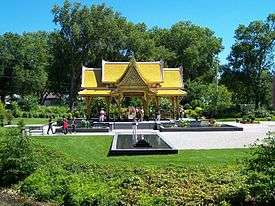
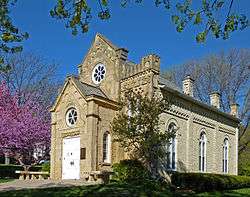
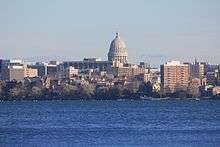
- Alliant Energy Center / Veteran's Memorial Coliseum and Exhibition Hall
- Camp Randall Stadium
- Chazen Museum of Art
- Madison Museum of Contemporary Art
- Madison Children's Museum
- Henry Vilas Zoo
- The Kohl Center
- Mifflin Street, home to the annual Mifflin Street Block Party
- Monona Terrace Community and Convention Center designed by Frank Lloyd Wright
- Memorial Union
- Olbrich Botanical Gardens
- Overture Center for the Arts
- The Gates of Heaven Synagogue in James Madison Park is the eighth-oldest-surviving synagogue building in the U.S.
- State Street
- Williamson ("Willy") Street
- Smart Studios, Butch Vig and Steve Marker's longtime studio where many notable alternative rock records of the 1990s and 2000s were recorded and/or produced
- Unitarian Meeting House, another notable and tourable Frank Lloyd Wright structure, is adjacent to Madison city limits in suburban Shorewood Hills
- University of Wisconsin–Madison
- University of Wisconsin–Madison Arboretum
- University of Wisconsin Field House
- UW–Madison Geology Museum
- Wisconsin Historical Society/Wisconsin Historical Museum
- Wisconsin Veterans Museum
- Wisconsin State Capitol
- Lakeshore Nature Preserve, a campus-associated preserve which features notable long peninsula called Picnic Point
Climate
Madison, along with the rest of the state, has a humid continental climate (Köppen: Dfb/Dfa), characterized by variable weather patterns and a large seasonal temperature variance: winter temperatures can be well below freezing, with moderate to occasionally heavy snowfall and temperatures reaching 0 °F (−18 °C) on 17 nights annually; high temperatures in summer average in the lower 80s °F (27–28 °C), reaching 90 °F (32 °C) on an average 12 days per year,[44] with lower humidity levels than winter but higher than spring. Summer accounts for a greater proportion of annual rainfall, but winter still sees significant precipitation.
| Climate data for Madison, Wisconsin (KMSN), 1981–2010 normals,[lower-alpha 1] extremes 1869–present[lower-alpha 2] | |||||||||||||
|---|---|---|---|---|---|---|---|---|---|---|---|---|---|
| Month | Jan | Feb | Mar | Apr | May | Jun | Jul | Aug | Sep | Oct | Nov | Dec | Year |
| Record high °F (°C) | 58 (14) |
68 (20) |
83 (28) |
94 (34) |
101 (38) |
101 (38) |
107 (42) |
102 (39) |
99 (37) |
90 (32) |
77 (25) |
65 (18) |
107 (42) |
| Mean maximum °F (°C) | 45.5 (7.5) |
51.1 (10.6) |
69.1 (20.6) |
79.6 (26.4) |
84.4 (29.1) |
90.9 (32.7) |
92.3 (33.5) |
91.1 (32.8) |
87.0 (30.6) |
78.5 (25.8) |
64.3 (17.9) |
49.0 (9.4) |
94.3 (34.6) |
| Average high °F (°C) | 26.4 (−3.1) |
31.1 (−0.5) |
43.1 (6.2) |
57.3 (14.1) |
68.4 (20.2) |
77.9 (25.5) |
81.6 (27.6) |
79.4 (26.3) |
71.8 (22.1) |
58.9 (14.9) |
44.1 (6.7) |
30.2 (−1.0) |
56.0 (13.3) |
| Average low °F (°C) | 11.1 (−11.6) |
15.1 (−9.4) |
24.8 (−4.0) |
35.8 (2.1) |
46.1 (7.8) |
56.1 (13.4) |
61.0 (16.1) |
59.0 (15.0) |
50.2 (10.1) |
38.8 (3.8) |
28.2 (−2.1) |
15.9 (−8.9) |
36.9 (2.7) |
| Mean minimum °F (°C) | −11.5 (−24.2) |
−6.6 (−21.4) |
5.0 (−15.0) |
19.8 (−6.8) |
31.0 (−0.6) |
41.4 (5.2) |
48.2 (9.0) |
46.3 (7.9) |
33.9 (1.1) |
24.0 (−4.4) |
11.8 (−11.2) |
−5.7 (−20.9) |
−15.7 (−26.5) |
| Record low °F (°C) | −37 (−38) |
−29 (−34) |
−29 (−34) |
0 (−18) |
19 (−7) |
31 (−1) |
36 (2) |
35 (2) |
25 (−4) |
12 (−11) |
−14 (−26) |
−28 (−33) |
−37 (−38) |
| Average precipitation inches (mm) | 1.23 (31) |
1.45 (37) |
2.20 (56) |
3.40 (86) |
3.55 (90) |
4.54 (115) |
4.18 (106) |
4.27 (108) |
3.13 (80) |
2.40 (61) |
2.39 (61) |
1.74 (44) |
34.48 (876) |
| Average snowfall inches (cm) | 12.9 (33) |
10.6 (27) |
7.0 (18) |
2.6 (6.6) |
0.2 (0.51) |
0 (0) |
0 (0) |
0 (0) |
0 (0) |
0.5 (1.3) |
3.6 (9.1) |
13.5 (34) |
50.9 (129) |
| Average precipitation days (≥ 0.01 in) | 10.2 | 9.2 | 10.5 | 12.1 | 11.9 | 11.1 | 10.6 | 9.4 | 9.3 | 9.8 | 10.6 | 10.1 | 124.8 |
| Average snowy days (≥ 0.1 in) | 9.8 | 7.9 | 5.8 | 2.0 | 0.2 | 0 | 0 | 0 | 0 | 0.5 | 3.8 | 8.7 | 38.7 |
| Average relative humidity (%) | 74.5 | 73.1 | 71.4 | 66.3 | 65.8 | 68.3 | 71.0 | 74.4 | 76.8 | 73.2 | 76.9 | 78.5 | 72.5 |
| Mean monthly sunshine hours | 143.0 | 152.3 | 187.3 | 206.7 | 263.1 | 293.1 | 304.9 | 270.2 | 213.8 | 172.5 | 111.4 | 109.5 | 2,427.8 |
| Percent possible sunshine | 49 | 52 | 51 | 51 | 58 | 64 | 66 | 63 | 57 | 50 | 38 | 39 | 54 |
| Source: NOAA (relative humidity and sun 1961–1990),[44][45][46] The Weather Channel[47] | |||||||||||||
Demographics
| Historical population | |||
|---|---|---|---|
| Census | Pop. | %± | |
| 1840 | 172 | — | |
| 1850 | 1,525 | 786.6% | |
| 1860 | 6,611 | 333.5% | |
| 1870 | 9,176 | 38.8% | |
| 1880 | 10,324 | 12.5% | |
| 1890 | 13,426 | 30.0% | |
| 1900 | 19,164 | 42.7% | |
| 1910 | 25,531 | 33.2% | |
| 1920 | 38,378 | 50.3% | |
| 1930 | 57,899 | 50.9% | |
| 1940 | 67,447 | 16.5% | |
| 1950 | 96,056 | 42.4% | |
| 1960 | 126,706 | 31.9% | |
| 1970 | 171,809 | 35.6% | |
| 1980 | 170,616 | −0.7% | |
| 1990 | 191,262 | 12.1% | |
| 2000 | 208,054 | 8.8% | |
| 2010 | 233,209 | 12.1% | |
| Est. 2019 | 259,680 | [3] | 11.4% |
| U.S. Decennial Census[48] | |||
As of 2000 the median income for a household in the city was $41,941, and the median income for a family was $59,840. Males had a median income of $36,718 versus $30,551 for females. The per capita income for the city was $23,498. About 5.8% of families and 15.0% of the population were below the poverty line, including 11.4% of those under age 18 and 4.5% of those age 65 or over.
2010 census
As of the census[2] of 2010, there were 233,209 people, 102,516 households, and 47,824 families residing in the city. The population density was 3,037.0 inhabitants per square mile (1,172.6/km2). There were 108,843 housing units at an average density of 1,417.4 per square mile (547.3/km2). The racial makeup of the city is 78.9 percent white, 7.3 percent black, 0.4 percent American Indian, 7.4 percent Asian, 2.9 percent other races, and 3.1 mixed race. Hispanic or Latino of any race consisted of 6.8 percent of the population.
There were 102,516 households of which 22.2% had children under the age of 18 living with them, 35.1% were married couples living together, 8.4% had a female householder with no husband present, 3.2% had a male householder with no wife present, and 53.3% were non-families. 36.2% of all households were made up of individuals and 7.5% had someone living alone who was 65 years of age or older. The average household size was 2.17 and the average family size was 2.87.
The median age in the city was 30.9 years. 17.5 percent of residents were under the age of 18; 19.6% were between the ages of 18 and 24; 31.4% were from 25 to 44; 21.9% were from 45 to 64; and 9.6% were 65 years of age or older. The gender makeup of the city was 49.2% male and 50.8% female.
Combined Statistical Area
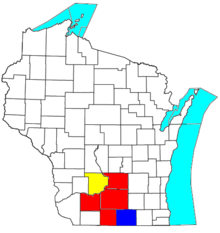
Madison is the larger principal city of the Madison-Janesville-Beloit, WI CSA, a Combined Statistical Area that includes the Madison metropolitan area (Columbia, Dane, Green and Iowa counties), the Janesville-Beloit metropolitan area (Rock County), and the Baraboo micropolitan area (Sauk County).[49][50][51] As of July 1, 2016, the Madison MSA had an estimated population of 648,929[52] and the Madison CSA had an estimated population of 874,498.[53]
Religion
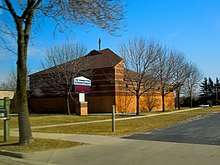
Madison is the episcopal see for the Roman Catholic Diocese of Madison.[54] Saint Raphael's Cathedral, damaged by arson in 2005 and demolished in 2008, was the mother church of the diocese. The steeple and spire survived and have been preserved with the intention they could be incorporated in the structure of a replacement building.[55]
InterVarsity Christian Fellowship/USA has its headquarters in Madison.
The Wisconsin Evangelical Lutheran Synod has three churches in Madison: Eastside Lutheran Church,[56] Our Redeemer Lutheran Church,[57] and Wisconsin Lutheran Chapel.[58]
The Evangelical Lutheran Synod has three churches in Madison: Grace Lutheran Church,[59] Holy Cross Lutheran Church,[60] and Our Saviour's Lutheran Church.[61]
Bethel Lutheran Church of the Evangelical Church in America, in downtown Madison, is one of the largest Lutheran congregations in the country.
Most American Christian movements are represented in the city, including mainline denominations, evangelical, charismatic and fully independent churches, including an LDS stake. The city also has multiple Sikhism temples, Hindu temples, three mosques and several synagogues, a Bahá'í community center, a Quaker Meeting House, and a Unity Church congregation.
The nation's third largest congregation of Unitarian Universalists,[62] the First Unitarian Society of Madison, makes its home in the historic Unitarian Meeting House, designed by one of its members, Frank Lloyd Wright.[63]
Madison also has a large atheist population. Madison is home to the Freedom from Religion Foundation, a non-profit organization that promotes the separation of church and state.
Economy
Madison's economy is marked by the sectors of tech business and state employment.
As of late 2018, the two largest employers in the Madison Metropolitan Area were the University of Wisconsin-Madison, and Epic Systems.[64] The Wisconsin state government and the University of Wisconsin Hospital and Clinics remain the two major state employers. Madison's economy today is evolving from a government-based economy to a consumer services and high-tech base, particularly in the health, biotech, and advertising sectors. Beginning in the early 1990s, the city experienced a steady economic boom and has been less affected by recession than other areas of the state. Underpinning the boom is the development of high-tech companies, many fostered by UW–Madison working with local businesses and entrepreneurs to transfer the results of academic research into real-world applications, especially bio-tech applications.
Many businesses are attracted to Madison's skill base, taking advantage of the area's high level of education. 48.2% of Madison's population over the age of 25 holds at least a bachelor's degree.[65] Forbes magazine reported in 2004 that Madison had the highest percentage of individuals holding Ph.D.s in the United States. Madison was also named in a number of Forbes 'Ten Best Cities' lists several times in the early 21st century.[66][67][68][69] In 2009, Madison was ranked number one in a list of "ten cities for job growth".[70]
State enterprises
As Madison is the State Capital of Wisconsin, it is home to many Wisconsin state agencies and bureaus. Madison also contains the University of Wisconsin-Madison, a research institution that employs 22,365 faculty and staff.[71]
The University of Wisconsin Hospital and Clinics is an important regional teaching hospital and regional trauma center, with strengths in transplant medicine, oncology, digestive disorders, and endocrinology.[72] Other Madison hospitals include St. Mary's Hospital,[73] Meriter Hospital, and the VA Medical Center.
Business
Madison was ranked in 2017 as the top city in the United States for tech growth.[74] In 2018, Madison was ranked in the top 10 cities for young entrepreneurs.[75] Madison is the only midwestern city to be listed in the top 20 cities for venture capital per capita.[76] The growth of Madison into an entrepreneurship hub was explained by one venture capitalist who described the city as "big enough that we have sufficient talent, resources, and capital to support our growing startup community, and small enough that you can readily plug into and feel a part of our community".[77]
Madison is home to companies such as Spectrum Brands (formerly Rayovac), Trek, Alliant Energy, the Credit Union National Association (CUNA), MGE Energy, Aprilaire, and Sub-Zero & Wolf Appliance. Insurance companies based in Madison include American Family Insurance, CUNA Mutual Group, and National Guardian Life. Technology companies in Madison include Google, Microsoft,[78] Broadjam, a regional office of CDW, Zendesk, Full Compass Systems, Raven Software, and TDS Telecom.
Some economic growth in Madison is driven by biotech and health information technology.[79] Biotech firms include Panvera (now part of Invitrogen), Exact Sciences, Promega, and Arrowhead Pharmaceuticals among others.[80] The contract research organization Covance is a major employer in the city.[81] Madison's community hackerspaces/makerspaces are Sector67, which serves inventors and entrepreneurs, and The Bodgery, which serves hobbyists, artists, and tinkerers. Start up incubators and connectors include StartingBlock, gener8tor and University Research Park. Epic Systems was based in Madison from 1979 to 2005, when it moved to a larger campus in the nearby Madison suburb of Verona. Other firms include Nordic, Forward Health, and Forte Research Systems.[82]
Oscar Mayer was a Madison fixture for decades, and was a family business for many years before being sold to Kraft Foods. The Onion satirical newspaper, as well as the pizza chains Rocky Rococo and the Glass Nickel Pizza Company, originated in Madison.[83][84]
Culture
In 1996 Money magazine identified Madison as the best place to live in the United States.[85] It has consistently ranked near the top of the best-places list in subsequent years, with the city's low unemployment rate a major contributor.[86] It was named first on Livability's top 100 places to live in 2014.[87]
In 2009, Madison ranked No. 2 on Newsmax magazine's list of the "Top 25 Most Uniquely American Cities and Towns," a piece written by CBS News travel editor Peter Greenberg.[88]
Food
According to some commentators Madison is home to "one of the strongest local foods scenes in the country".[89] The city is home to several James Beard Award winners, gastropubs, and farm-to-table restaurants.[90]
Local and regional foods unique to Madison include Blue moon flavored ice cream, Brandy old fashioneds, and Bratwurst. Madison is also home to unique foods such as the large spring-rolls sold from the food carts on the Capital Square and State Street, particularly in warmer months.[91] Other foods that are unique to the area are cheese curds either fried or dipped in ranch dressing and hot and spicy cheese bread made by some Madison bakeries and available at farmer's markets around the city.[92]
On Saturday mornings in the summer, the Dane County Farmers' Market is held around the Capitol Square, the largest producer-only farmers' market in the country.[93] A smaller version of this market is held on Martin Luther King Boulevard on Wednesdays during the summer.[94] In late fall, this market moves indoors, first as the Holiday Market[95] at the Monona Terrace. Later it becomes the Late Winter Market[96] at the Madison Senior Center. This market attracts numerous vendors who sell fresh produce, meat, cheese, and other products.
Some restaurants in Madison follow the general Wisconsin supper club practice of restaurants serving "Friday fish fry, Saturday prime rib special, Sunday chicken dinner special."[97] The Great Taste of the Midwest craft beer festival, established in 1987 and the second-longest-running such event in North America,[98] is held the second Saturday in August. The highly coveted tickets sell out within an hour of going on sale in May.[99]
Outdoor activities
Madison was ranked as America's Fittest City in April 2016.[100] During the winter months, sports enthusiasts enjoy ice-boating, ice skating, ice hockey, ice fishing, cross-country skiing, and snowkiting.[101] During the rest of the year, outdoor recreation includes sailing on the local lakes, bicycling, and hiking.
Madison is known for its extensive biking infrastructure, with numerous bike paths and bike lanes throughout the city. Several of these bike paths connect to state trails, such as the Capital City State Trail, Military Ridge State Trail, and Badger State Trail. In addition to these bike paths, most city streets have designated bike lanes or are designated as bicycle boulevards, which give high priority to bicyclists. In 2015 Madison was awarded platinum level Bicycle Friendly Community designation from the League of American Bicyclists, one of only five cities in the US to receive this (highest) level.[102]
Nightlife
Downtown Madison is central to much of the nightlife in the city. Students from the University of Wisconsin-Madison visit spots on State Street and the surrounding area on weekends.[103] Bars in the Capital Square neighborhood are less frequented by students and more by young professionals and work happy hours.[104] Another center of nightlife is the bohemian Willy Street Neighborhood. Madison is also home to a number of nightclubs, gay bars and live music venues.
Among the city's neighborhood fairs and celebrations are two large student-driven gatherings, the Mifflin Street Block Party and the State Street Halloween Party. Rioting and vandalism at the State Street gathering in 2004 and 2005 led the city to institute a cover charge for the 2006 celebration.[105] In an attempt to give the event more structure and to eliminate vandalism, the city and student organizations worked together to schedule performances by bands, and to organize activities. The event has been named "Freakfest on State Street."[106] Events such as these have helped contribute to the city's nickname of "Madtown."
Music
Madison's music scene covers a spectrum of musical culture.[107]
Several venues offer live music nightly, spreading from the historic Barrymore Theatre and High Noon Saloon on the east side to[108] small coffee houses and wine bars. The biggest headliners sometimes perform at the Orpheum Theatre, the Overture Center, Breese Stevens Field, the Alliant Energy Center, or the UW Theatre on campus. Other major rock and pop venues include the Majestic Theatre, the Sylvee, and The Bartell. During the summer, the Memorial Union Terrace on the University of Wisconsin campus, offers live music five nights a week. The Union is located on the shores of Lake Mendota.
Concerts on the Square is a weekly Madison tradition during the summer. On Wednesday evenings, the Wisconsin Chamber Orchestra performs free concerts on the capitol's lawn,[109] and people come to listen to the music while picnicking on the grass.
The Madison Scouts Drum and Bugle Corps has provided youth aged 16–22 opportunities to perform across North America every summer since 1938. The University of Wisconsin Marching Band is a local marching band.
Madison has a lively independent rock scene, and local independent record labels include Crustacean Records, Science of Sound,[110] Kind Turkey Records,[111] and Art Paul Schlosser Inc. A Dr. Demento[112] and weekly live karaoke[113] favorite is The Gomers,[114] who have a Madison Mayoral Proclamation named after them.[115] They have performed with fellow Wisconsin residents Les Paul and Steve Miller.[116]
Madison is also home to other nationally known artists such as Paul Kowert of Punch Brothers, Mama Digdown's Brass Band, Clyde Stubblefield of Funky Drummer and James Brown fame, and musicians Roscoe Mitchell, Richard Davis, Ben Sidran, Sexy Ester and the Pretty Mama Sisters, Reptile Palace Orchestra, Ted Park, DJ Pain 1, Killdozer, Zola Jesus, VO5, Caustic, PHOX, Masked Intruder, and Lou & Peter Berryman, among others. The band Garbage formed in Madison in 1994, and has sold 17 million albums.[117]
In the summer Madison hosts many music festivals, including the Waterfront Festival, the Willy St. Fair, Atwood Summerfest, the Isthmus Jazz Festival, the Orton Park Festival, 94.1 WJJO's Band Camp, Greekfest, the WORT Block Party and the Sugar Maple Traditional Music Festival, and the Madison World Music Festival sponsored by the Wisconsin Union Theater (held at the Memorial Union Terrace and at the Willy St. Fair in September). Past festivals include the Madison Pop Festival and Forward Music Festival (2009–2010.) One of the latest additions is the Fête de Marquette, taking place around Bastille Day at various east side locations. This new festival celebrates French music, with a focus on Cajun influences. Madison also hosts an annual electronic music festival, Reverence, and the Folk Ball, a world music and Folk dance festival held annually in January. Madison is home to the LBGTQA festival, Fruit Fest, celebrating queer culture and LGBT allies. Madison also plays host to the National Women's Music Festival.[118] UW-Madison also hosts the annual music and arts festival, Revelry, on campus at the Memorial Union each spring. The festival is put on by students for students as an end of the year celebration on campus.[119]
Art
Art museums include the UW–Madison's Chazen Museum of Art (formerly the Elvehjem Museum), and the Madison Museum of Contemporary Art, which annually organizes the Art Fair on the Square. Madison also has independent art studios, galleries, and arts organizations, with events such as Art Fair Off the Square. Other museums include Wisconsin Historical Museum (run by the Wisconsin Historical Society),[120] the Wisconsin Veterans Museum,[121] and the Madison Children's Museum.[122]
Performing arts
The Madison Opera, the Madison Symphony Orchestra, Forward Theater Company, the Wisconsin Chamber Orchestra, and the Madison Ballet are some of the professional resident companies of the Overture Center for the Arts. The city is also home to a number of smaller performing arts organizations, including a group of theater companies that present in the Bartell Theatre, a former movie palace renovated into live theater spaces, and Opera for the Young, an opera company that performs for elementary school students across the Midwest. The Wisconsin Union Theater (a 1,300-seat theater) is home to seasonal attractions and is the main stage for Four Seasons Theatre, a community theater company specializing in musical theater, and other groups. The Young Shakespeare Players, a theater group for young people, performs uncut Shakespeare and George B. Shaw plays.
Community-based theater groups include Children's Theatre of Madison, Strollers Theatre, Madison Theatre Guild, the Mercury Players, and Broom Street Theater (which is no longer on Broom Street).
Madison has one comedy club, the Comedy Club on State (which has hosted the Madison's Funniest Comic competition every year since 2010), owned by the Paras family. Madison has other options for more alternative humor, featuring several improv groups, such as Atlas Improv Company, Monkey Business Institute, and open mic nights.
Madison is home to a large entertainment industry archive at the Wisconsin Center for Film and Theater Research, part of the Wisconsin Historical Society.[123]
Politics
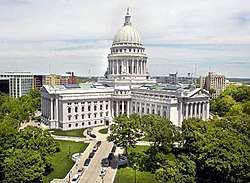
City voters have supported the Democratic Party in national elections in the last half-century, and a liberal and progressive majority is generally elected to the city council. Detractors often refer to Madison as "77 square miles surrounded by reality" a phrase coined by former Wisconsin Republican governor Lee S. Dreyfus, while campaigning in 1978.[124] In 2013, there was a motion in the city council to turn Dreyfus' humor into the official city "punchline," but it was voted down by the city council.[125]
The city's voters are generally much more liberal than voters in the rest of Wisconsin. For example, 76% of Madison voters voted against a 2006 state constitutional amendment to ban gay marriage,[126] even though the ban passed statewide with 59% of the vote.[127]
In 1992, a local third party, Progressive Dane, was founded. City policies supported in the Progressive Dane platform have included an inclusionary zoning ordinance, later abandoned by the mayor and a majority of the city council, and a city minimum wage. The party holds several seats on the Madison City Council and Dane County Board of Supervisors, and is aligned variously with the Democratic and Green parties.
Other cultural events
In 2005, Madison was included in Gregory A. Kompes' book, 50 Fabulous Gay-Friendly Places to Live.[128] The Madison metro area has a higher percentage of gay couples than any other city in the area outside of Chicago and Minneapolis.[129]
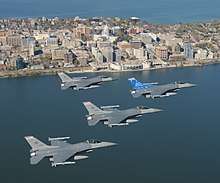
Madison was host to Rhythm and Booms, a large fireworks celebration coordinated to music. It began with a fly-over by F-16s from the local Wisconsin Air National Guard. This celebration was the largest fireworks display in the Midwest in length, number of shells fired, and the size of its annual budget.[130] Effective 2015, the event location was changed to downtown and renamed Shake The Lake.[131][132]
There are several cooperative organizations in the Madison area, ranging from grocery stores (such as the Willy Street Cooperative) to housing co-ops (such as Madison Community Cooperative and Nottingham Housing Cooperative) to worker cooperatives (including an engineering firm, a wholesale organic bakery and a cab company).
Every April, the Wisconsin Film Festival is held in Madison.[133] This five-day event features films from a variety of genres shown in theaters across the city. The University of Wisconsin–Madison Arts Institute sponsors the Film Festival.[134]
Madison is known for its unique official bird. In 2009, the Madison Common Council voted to name the plastic pink flamingo as the official city bird.[135]
Sports
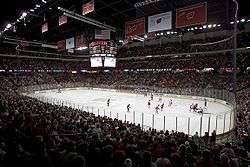
Madison is known for having the athletics fanbase which centers on the University of Wisconsin-Madison. In 2003, Sports Illustrated identified the city as one of the "best college sports towns" in the nation.[144] In 2019, Sports Illustrated named Madison the greatest college football town in the nation.[145] Scott Van Pelt also proclaimed Madison the best college sports town in America[146] due to the popularity of Wisconsin Badgers football. On game day, the city can look like a wave of red and white, and the downtown area is packed full of tailgates and celebrations.
The UW–Madison teams play their home-field sporting events in venues in and around Madison. The Wisconsin Badgers football team plays at Camp Randall Stadium where crowds of as many as 83,000 have attended games. The Wisconsin Badgers men's basketball and Wisconsin Badgers men's ice hockey teams play at the Kohl Center. Construction on the $76 million arena was completed in 1997. The Wisconsin Badgers women's ice hockey team plays at the LaBahn Arena. Some events are played at the county-owned Alliant Energy Center (formerly Dane County Memorial Coliseum) and the University-owned Wisconsin Field House.[147]
In 2014, the Madison Capitols made their return to the Madison area following 19 years of dormancy. The Capitols play their home games at Bob Suter's Capitol Ice Arena following three years at Alliant Energy Center.[148]
On May 17, 2018, it was announced that Forward Madison FC would become Madison's first professional soccer team, which plays at the historic Breese Stevens Field.[149]
Madison is home to the Madison Mallards, a college wood-bat summer baseball league team in the Northwoods League. They play in Warner Park on the city's north side from June to August.[150]
Prominent sports teams
| Club | Sport | League | Venue | Founded |
|---|---|---|---|---|
| Wisconsin Badgers | Various | NCAA | Camp Randall Stadium, Kohl Center | 1849 |
| Madison Mallards | Baseball | NL | Warner Park | 2001 |
| Madison Radicals | Ultimate | AUDL | Breese Stevens Field | 2013 |
| Madison Capitols | Ice Hockey | United States Hockey League | Bob Suter's Capitol Ice Arena | 2014 |
| Forward Madison FC | Soccer | USL League One | Breese Stevens Field | 2018 |
Former teams
The Madison Muskies, a Class A, Midwest League affiliate of the Oakland A's, left town in 1993 after 11 seasons. The Madison Hatters, another Class A, Midwest League team, played in Madison for only the 1994 season. The Madison Black Wolf, an independent Northern League franchise lasted five seasons (1996–2000), before decamping for Lincoln, Nebraska.
Amateur sports
Madison has an active amateur sports scene, with ultimate, endurance sports, and soccer being common pastimes.
Madison has several active ultimate disc leagues organized through the nonprofit Madison Ultimate Frisbee Association.[151] In 2013, the Madison Radicals, a professional ultimate frisbee team, debuted in the city.[152]
Madison is home to several endurance sports racing events, such as the Crazylegs Classic, the CrossFit Games, Paddle and Portage, the Mad City Marathon, and Ironman Wisconsin, which attracts over 45,000 spectators.[153]
The Wisconsin Rugby Club, the 1998 and 2013 USA Rugby Division II National Champions, and the Wisconsin Women's Rugby Football Club are the state's only Division I women's rugby team. All Madison rugby teams play within the Wisconsin Rugby Football Union — the Midwest Rugby Union and USA Rugby.
The Madison Curling Club was founded in 1921.[154] Team Spatola of the Madison Curling Club won the 2014 Women's US National Championship. Team members are: Nina Spatola, Becca Hamilton, Tara Peterson, Sophie Brorson.[155]
Madison's Gaelic sports club hosts a hurling team organized as The Hurling Club of Madison and a Gaelic football club with men's and women's teams.
The roller derby league, Madison Roller Derby, was formed in Madison in 2004 and is a member of the Women's Flat Track Derby Association.[156] Madison is also home to Wisconsin United Roller Derby, a member league of the Men's Roller Derby Association.[157]
The adult women's ice hockey teams (Thunder, Lightning, Freeze, UW–B and C teams) play in the Women's Central Hockey League.
The Blackhawk Ski Club, formed in 1947, provides ski jumping, cross country skiing and alpine skiing. The club's programs have produced several Olympic ski jumpers, two Olympic ski jumping coaches and one Olympic ski jumping director. The club had the first Nordic ski facility with lighted night jumping.
As of 2017, the CrossFit Games have been held at the Alliant Energy Center. After seven years at the StubHub Center in Carson, California, the Games moved to Madison for an initial three-year contract. CrossFit chose the multi-building entertainment venue, which encompasses 164 acres, after posting a national request for proposals.[158]
Parks
Madison has 6,431 acres of park space, which is 13.5% of the total city area.[159] The city has 12.7 parks per 10,000 residents, more than any other city.[160] Parks in the city include James Madison Park, which has views of Lake Mendota, Frank W. Hoyt Park, which is listed on the National Register of Historic Places, Garner park, where the Madison Opera hold an 'Opera in the Park' event,[161] and Warner Park, which is home to the stadium for the baseball team the Madison Mallards.
Government
Madison has a mayor-council system of government. Madison's city council, known as the Common Council, consists of 20 members, one from each district. The mayor is elected in a citywide vote.
Madison is the heart of Wisconsin's 2nd congressional district in the United States House of Representatives, represented by Mark Pocan (D). Mark F. Miller (D) and Fred Risser (D) represent Madison in the Wisconsin State Senate, and Robb Kahl (D), Melissa Sargent (D), Chris Taylor (D), Sheila Stubbs (D), and Lisa Subeck (D) represent Madison in the Wisconsin State Assembly.
Ron Johnson (R) and Tammy Baldwin (D) represent Madison, and all of Wisconsin, in the United States Senate. Baldwin is a Madison resident; she represented the 2nd from 1999 to 2013 before handing it to Pocan.
Madison Police Department
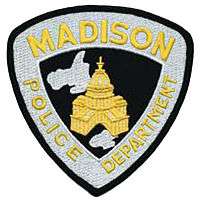
The Madison Police Department is the law enforcement agency in the city. It has been led by Chief Michael Koval since 2014.[162] The department has six districts: Central, East, North, South, West and Midtown District[163]
Special units in the police department include:
- K9 Unit
- Crime Scene Unit
- Forensic Unit
- Narcotics and Gangs Task Force
- Parking Enforcement
- Traffic Enforcement Safety Team
- S.W.A.T Team
- Special Events Team
- C.O.P.S (Safety Education)
- Mounted Patrol
- Crime Stoppers
- Amigos en Azul
The Madison Police Department was criticized for absolving Officer Steve Heimsness of any wrongdoing in the November 2012 shooting death of an unarmed man, Paul Heenan. The department's actions resulted in community protests, including demands that the shooting be examined and reviewed by an independent investigative body.[164] WisconsinWatch.org called into question the MPD's facts and findings, stating that the use of deadly force by Heimsness was unwarranted.[165] There were calls for an examination of the Madison Police Department's rules of engagement and due process for officers who use lethal force in the line of duty.
Community criticism of the department's practices resurfaced after MPD officer Matt Kenny shot Tony Robinson, an unarmed man. The shooting was particularly controversial given the context of the ongoing Black Lives Matter movement. Due to new Wisconsin state legislation[166] that addresses the mechanisms under which officer-on-civilian violence is handled by state prosecutors, proceedings were handed over to a special unit of the Wisconsin Department of Justice in Madison. On March 27, 2015, the state concluded its investigation and gave its findings to Ismael Ozanne, the district attorney of Dane County.[167] On May 12, 2015, Ozanne determined that the shooting was justified self-defense.[168]
Madison Fire Department
The Madison Fire Department (MFD) provides fire protection and emergency medical services to the city. The MFD operates out of 14 fire stations,[169] with a fleet of 12 engines, 5 ladders,[170] 2 rescue squads, 2 hazmat units,[171] a lake rescue team,[172] and 8 ambulances.[173] The MFD also provides mutual aid to surrounding communities.[174][175][176]
Crime
| Year | Homicides | Robbery | Burglary |
|---|---|---|---|
| 1976[177] | 6 | 114 | 2292 |
| 1977[178] | 4 | 122 | 2440 |
| 1986[177] | 3 | 211 | 1988 |
| 1996[177] | 1 | 301 | 1389 |
| 1999[177] | 6 | 265 | 1356 |
| 2000[178] | 4 | 286 | 1267 |
| 2001[178] | 6 | 295 | 1358 |
| 2002[178] | 5 | 269 | 1570 |
| 2003[178] | 6 | 282 | 1611 |
| 2004[178] | 3 | 292 | 1467 |
| 2005[178] | 3 | 330 | 1462 |
| 2006[178] | 4 | 435 | 1627 |
| 2007[178] | 8 | 410 | 2059 |
| 2008[178] | 10 | 368 | 2038 |
| 2009[178] | 4 | 364 | 1523 |
| 2010[179] | 2 | 333 | 1652 |
| 2011[179] | 7 | 272 | 1446 |
| 2012[180] | 3 | 249 | 1594 |
| 2013[180] | 5 | 301 | 1360 |
| 2014[181] | 5 | 225 | 1126 |
| 2015[181] | 6 | 222 | 1208 |
In 2008, Men's Health magazine ranked Madison as the "Least Armed and Dangerous" city in the United States in an article about "Where Men Are Targets".[182] There were 53 homicides reported by Madison Police from 2000 to 2009.[178] The highest total was 10 in 2008.[183] Police reported 28 murders from 2010 to 2015, with the highest year being 7 murders in 2011.[179][180][181]
Education
According to Forbes magazine, Madison ranks second in the nation in education.[184][185] The Madison Metropolitan School District serves the city while a variety of other districts serve the surrounding area. With an enrollment of approximately 25,000 students in 46 schools, it is the second largest school district in Wisconsin behind the Milwaukee School District.[186] The five public high schools are James Madison Memorial, Madison West, Madison East, La Follette, and Malcolm Shabazz City High School, an alternative school.
Among private church-related high schools are Abundant Life Christian School, Edgewood High School,[187] near the Edgewood College campus, and St. Ambrose Academy, a Catholic school offering grades 6 through 12.[188] Madison Country Day School is a private high school with no religious affiliation.
The city is home to the University of Wisconsin–Madison, Edgewood College and Madison Area Technical College, giving the city a post-secondary student population of nearly 55,000. The University of Wisconsin accounts for the vast majority of students, with an enrollment of roughly 44,000, of whom 31,750 are undergraduates.[189] In a Forbes magazine city ranking from 2003, Madison had the highest number of Ph.D.s per capita, and third-highest college graduates per capita, among cities in the United States.[190]
Additional degree programs are available through satellite campuses of Cardinal Stritch University, Concordia University-Wisconsin, Globe University, Lakeland College, the University of Phoenix, and Upper Iowa University. Madison also has a non-credit learning community with multiple programs and many private businesses also offering classes.
Media
Print
Madison is home to an extensive and varied number of print publications, reflecting the city's role as the state capital and its diverse political, cultural and academic population. The Wisconsin State Journal (weekday circulation: ~95,000; Sundays: ~155,000) is published in the mornings, while its sister publication, The Capital Times (Thursday supplement to the Journal) is published online daily, with two printed editions a week. Though jointly operated under the name Capital Newspapers, the Journal is owned by the national chain Lee Enterprises, and the Times is independently owned. Wisconsin State Journal is the descendant of the Wisconsin Express, a paper founded in the Wisconsin Territory in 1839. The Capital Times was founded in 1917 by William T. Evjue, a business manager for the State Journal who disagreed with that paper's editorial criticisms of Wisconsin Republican Senator Robert M. La Follette, Sr. for his opposition to U.S. entry into World War I.
The free weekly alternative newspaper Isthmus (weekly circulation: ~65,000) was founded in Madison in 1976. The Onion, a satirical weekly, was founded in Madison in 1988 and published from there until it moved to New York in 2001. Two student newspapers are published during the academic year, The Daily Cardinal (Mon-Fri circulation: ~10,000) and The Badger Herald (Mon-Fri circulation: ~16,000). Other specialty print publications focus on local music, politics and sports, including The Capital City Hues,[191][192][193] The Madison Times,[192][193] Madison Magazine, The Simpson Street Free Press, Umoja Magazine,[192][193][194][195] and fantasy-sports web site RotoWire.com. Local community blogs include Althouse and dane101.
Madison is associated with "Fighting Bob" La Follette and the Progressive movement. La Follette's magazine, The Progressive, founded in 1909, is still published in Madison. It is a left-wing periodical that may be best known for the attempt of the U.S. government in 1979 to suppress one of its articles before publication. The magazine eventually prevailed in the landmark First Amendment case, United States v. The Progressive, Inc. During the 1970s, there were two radical weeklies published in Madison, known as TakeOver and Free for All, as well as a Madison edition of the Bugle-American underground newspaper.
Radio
Madison has three large media companies that own the majority of the commercial radio stations within the market. These companies consist of iHeartMedia, Entercom Communications, and Mid-West Family Broadcasting as well as other smaller broadcasters. Madison is home to Mid-West Family Broadcasting, which is an independently owned broadcasting company that originated and is headquartered in Madison. Mid-West Family owns radio stations throughout the state and the Midwest.
Madison hosts two volunteer-operated and community-oriented radio stations, WORT and WSUM. WORT Community Radio (89.9 FM), founded in 1975, is one of the oldest volunteer-powered radio stations in the United States. A listener-sponsored community radio station, WORT offers locally produced diverse music and talk programming. WSUM (91.7 FM) is a free-form student radio station programmed and operated almost entirely by students.
Madison's Wisconsin Public Radio station, WHA, was one of the first radio stations in the nation to begin broadcasting.[196] Public radio programs that originate at the WPR studios include Michael Feldman's Whad'Ya Know?, Zorba Pastor On Your Health, To the Best of Our Knowledge,Calling All Pets, and the longest running radio program in America, Chapter a Day.
WXJ-87 is the NOAA Weather Radio All Hazards station on Madison's west side, with broadcasts originating from the National Weather Service in Sullivan, Wisconsin.
TV
Madison has six commercial stations, two public television stations and two religious stations. The commercial stations consist of WISC-TV "News 3 Now" (CBS), WMTV "NBC 15" (NBC), WKOW-TV "27 News" (ABC), WMSN-TV "FOX 47" (Fox), WIFS "Wisconsin's 57" (Ion Life) and WZCK-LD. The religious stations consist of WMWD (Daystar) and W23BW-D (3ABN), Madison has two public television stations: WHA-TV, which is owned by the University of Wisconsin–Extension, airs throughout the state, with the exception of Milwaukee, and Madison City Channel, which is owned and operated by the City of Madison covering city governmental affairs.
Transportation
Madison is served by the Dane County Regional Airport, which serves nearly 2.2 million passengers annually. Most major general aviation operations take place at Morey Field in Middleton 15 miles (24 km) from Madison's city center. Madison Metro operates bus routes throughout the city and to some neighboring suburbs.[197] Madison has four taxicab companies (Union, Badger, Madison, and Green), and several companies provide specialized transit for individuals with disabilities. Several carsharing services are also available in Madison, including Community Car, a locally owned company, and U-Haul subsidiary Uhaul Car Share.
Starting from the last decades of the 20th century, Madison has been among the leading cities for bicycling as a form of transportation, with about 3% of working residents pedaling on their journey to work.[198] The share of Madison workers who bicycled to work increased to 5.3% by 2014.[199] According to the 2016 American Community Survey, 65.7% of working Madison residents commuted by driving alone, 6.7% carpooled, 8.6% used public transportation, and 8.5% walked. About 6% used all other forms of transportation, including bicycles, motorcycles, and taxis. About 4.5% worked at home.[200]
In 2015, 11.2% of Madison households were without a car, which was unchanged in 2016. The national average was 8.7% in 2016. Madison averaged 1.5 cars per household in 2016, compared to a national average of 1.8 per household.[201]
Railways
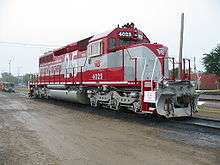
Passenger train service between Madison and Chicago on the Sioux and the Varsity was provided by the Chicago, Milwaukee, St. Paul and Pacific Railroad (Milwaukee Road) until 1971. The Chicago and North Western Railway also provided service to the east side of Madison, ending in 1965. A high-speed rail route from Chicago through Milwaukee and Madison to Minneapolis–Saint Paul, Minnesota, was proposed as part of the Midwest Regional Rail Initiative. Funding for the railway connecting Madison to Milwaukee was approved in January 2010, but then Governor-elect Scott Walker's opposition to the project led the Federal Railroad Administration to retract the $810 million in funding and reallocate it to other projects.[202] The city is served by the Columbus Amtrak station 28 miles (45 km) to the northeast with once daily trains to Chicago, Portland, OR and Seattle, WA and stops in between via the Empire Builder route. While located outside of the city proper the station is listed on Amtrak timetables as Madison's official stop in addition to thruway bus services within the city.[203]
Railroad freight services are provided to Madison by the Wisconsin and Southern Railroad (WSOR) and the Canadian Pacific Railway (CP).
Buses
In addition to public transportation, regional buses connect Madison to Milwaukee, Chicago, Minneapolis–Saint Paul, and many other communities. Badger Bus,[204] which connects Madison and Milwaukee, runs several trips daily. Greyhound Lines, a nationwide bus company, serves Madison on its Chicago, Milwaukee, and Minneapolis–Saint Paul route. Van Galder Bus Company, a subsidiary of Coach USA, provides transportation through Rockford to Chicago—stopping at Union Station, O'Hare Airport, and Midway Airport. Jefferson Lines provides transportation to Minneapolis–Saint Paul via La Crosse. Megabus provides limited-stop service to Chicago and Minneapolis–Saint Paul. Lamers Bus Lines has once daily trips from Madison to Wausau, Dubuque, and Green Bay.
Highways
Interstate 39 (I-39), I-90 and I-94 run along the far east side of the city, connecting to Janesville to the south, Milwaukee to the east, and to Portage, La Crosse, Eau Claire, and Wausau heading north and northwest.
U.S. Highway 151 (US 151) runs through downtown and serves as the main thoroughfare through the northeast (as Washington Avenue) and south-central parts (as Park Street) of the city, connecting Madison with Dubuque, Iowa to the southwest and Fond du Lac and Manitowoc to the northeast.
US 12, frequently referred to by locals as the Beltline, is a six- to eight-lane freeway serving the south and west sides of Madison and is the main link from the west suburb of Middleton to Cambridge. Southeast of the area, US 12 connects to Lake Geneva, and going northwest, it heads to Wisconsin Dells.
US 18 is also a component highway of the Beltine, continuing south along US 151 and east towards Waukesha and Milwaukee.
Notable people
Sister cities
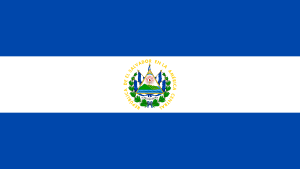
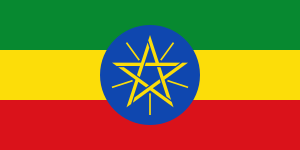


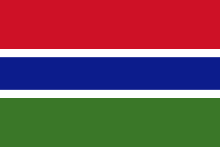




See also
Notes
- Mean monthly maxima and minima (i.e. the expected highest and lowest temperature readings at any point during the year or given month) calculated based on data at said location from 1981 to 2010.
- Official weather records for Madison were kept at downtown from January 1869 to December 1946 and at KMSN since January 1947. For more information, see ThreadEx.
References
- "2019 U.S. Gazetteer Files". United States Census Bureau. Retrieved August 7, 2020.
- "U.S. Census website". United States Census Bureau. Retrieved November 18, 2012.
- "Population and Housing Unit Estimates". Retrieved May 21, 2020.
- "ZIP Code Lookup". USPS. Archived from the original on January 1, 2008. Retrieved October 3, 2014.
- "Census: Madison, suburbs top list of fastest-growing cities in Wisconsin". Madison.com. Retrieved July 24, 2020.
- "Protests & Social Action at UW-Madison during the 20th Century". UW Archives and Records Management. June 23, 2015. Archived from the original on January 26, 2019. Retrieved January 26, 2019.
- "The Long-Term Effect Of Wisconsin's Union Battles". NPR.org. Archived from the original on January 26, 2019. Retrieved January 26, 2019.
- Meyerhofer, Kelly. "Dane, Milwaukee counties fueled Democratic wins; college students also helped". madison.com. Archived from the original on January 26, 2019. Retrieved January 26, 2019.
- "Patch". Patch. Archived from the original on November 23, 2018. Retrieved November 22, 2018.
- "Data USA". Data USA. Archived from the original on July 18, 2019. Retrieved July 17, 2019.
- "Wisconsin gains national attention as start-up technology hub". Milwaukee Journal Sentinel. Archived from the original on March 27, 2019. Retrieved January 26, 2019.
- "Googling Madison: Software engineers boost tech giant". news.wisc.edu. Archived from the original on January 26, 2019. Retrieved January 26, 2019.
- "About - University Research Park Madison". Archived from the original on January 26, 2019. Retrieved January 26, 2019.
- Petrovic, Pheobe. "Madison Ranks High Globally For Startup Cities". Wisconsin Public Radio. Wisconsin Public Radio. Archived from the original on March 26, 2019. Retrieved March 26, 2019.
- "The 20th-Century Architecture of Frank Lloyd Wright". UNESCO. Archived from the original on July 9, 2019. Retrieved July 17, 2019.
- "A History of Madison" (PDF). morgridge.wiscweb.wisc.edu. Archived (PDF) from the original on December 21, 2018. Retrieved December 20, 2018.
- "Life in Early Madison". Wisconsin Historical Society. June 27, 2012. Archived from the original on December 21, 2018. Retrieved December 20, 2018.
- Mollenhoff, David V. (2003) Madison, a History of the Formative Years Archived January 16, 2017, at the Wayback Machine Madison: University of Wisconsin Press. ISBN 0-299-19980-0. Page 26.
- Historic Madison, Inc., Madison's Past – Early History Archived June 23, 2012, at the Wayback Machine
- Supreme Court, History: The Supreme Court Hearing Room Archived January 12, 2018, at the Wayback Machine Wisconsin Court System.
- "Madison, Wisconsin - A Brief History". Wisconsinhistory.org. Wisconsin Historical Society. Archived from the original on January 10, 2019. Retrieved January 9, 2019.
- "Vilas vs. Reynolds". Reports of cases argued and determined in the Supreme Court of the State of Wisconsin. 6. Beloit: E.E. Hale & Co. 1858. p. 215. Retrieved July 24, 2011.
- Madison, Dane County and Surrounding Towns Archived July 24, 2014, at the Wayback Machine, Madison: Wm. J. Park, 1877, pp. 543–558.
- "Wisconsin State Capitol Tour". State of Wisconsin. Archived from the original on May 27, 2007. Retrieved May 24, 2007.
- "The War at Home (1979) Review Summary". The New York Times. Archived from the original on July 10, 2012. Retrieved July 10, 2012.
- Davey, Monica; Greenhouse, Steven (February 17, 2011). "Angry Demonstrations in Wisconsin as Cuts Loom". The New York Times. Archived from the original on December 9, 2016. Retrieved December 8, 2016.
- "Up to 100,000 protest Wisconsin law curbing unions". Reuters. March 13, 2011. Archived from the original on December 16, 2018. Retrieved December 14, 2018.
- "US Gazetteer files 2010". United States Census Bureau. Archived from the original on July 2, 2012. Retrieved November 18, 2012.
- "Dictionary of Wisconsin History: Four Lakes". Wisconsin Historical Society. Archived from the original on May 23, 2006. Retrieved October 24, 2006.
- "City of Madison Website, Communities and Neighborhoods". Archived from the original on March 7, 2011. Retrieved March 4, 2011.
- Times, Steven Elbow | The Capital. "Madison's Williamson-Marquette neighborhood named one of nation's top 10". madison.com. Archived from the original on July 18, 2018. Retrieved July 17, 2018.
- Adams, Barry. "University Hill Farms neighborhood features long-time residents, newcomers and development". Madison.com. Wisconsin State Journal. Archived from the original on March 26, 2019. Retrieved March 26, 2019.
- "Welcome to Capitol Neighborhoods". City of Madison. City of Madison. Archived from the original on March 26, 2019. Retrieved March 26, 2019.
- Armitage, Lynn. "Capitol Neighborhoods: The heart of the city". Channel3000. Madison Magazine. Archived from the original on March 26, 2019. Retrieved March 26, 2019.
- Rath, Jay. "Welcome to Madison's Park Street: Its checkered past gives way to a bright future". Isthmus. Isthmus. Archived from the original on March 26, 2019. Retrieved March 26, 2019.
"It's by far the most racially and economically diverse area of Madison," says Lindsey Lee, owner of Cargo Coffee, 1309 S. Park St. Lee
- "Dudgeon-Monroe Neighborhood". City of Madison. City of Madison. Archived from the original on March 26, 2019. Retrieved March 26, 2019.
- "Welcome to Marquette Neighborhood Association". City of Madison. City of Madison. Archived from the original on March 26, 2019. Retrieved March 26, 2019.
- Adams, Barry. "Iconic Madison neighborhoods Willy Street, Monroe Street celebrate 40th year events". Madison.com. Wisconsin State Journal. Archived from the original on March 26, 2019. Retrieved March 26, 2019.
- "Yahara lakes were home to dense and most varied native mounds". Wisconsin State Journal. Archived from the original on July 17, 2019. Retrieved July 17, 2019.
- "Frank Lloyd Wright Architecture by City and State". ThoughtCo. Archived from the original on June 15, 2019. Retrieved July 17, 2019.
- "1989 Wisconsin Act 222" (PDF). State of Wisconsin. April 12, 1990. Archived (PDF) from the original on October 11, 2006. Retrieved October 3, 2006.
- "Behold ... The Genius Of Claude And Starck Archived September 29, 2008, at the Wayback Machine
- "By any measure, Madison is getting taller". madison.com. Archived from the original on October 2, 2017. Retrieved May 22, 2015.
- "NowData – NOAA Online Weather Data". National Oceanic and Atmospheric Administration. Retrieved March 9, 2018.
- "Station Name: WI MADISON DANE RGNL AP". National Oceanic and Atmospheric Administration. Retrieved March 9, 2018.
- "WMO Climate Normals for MADISON/DANE CO REGIONAL ARPT, WI 1961–1990". National Oceanic and Atmospheric Administration. Retrieved March 10, 2014.
- "Monthly Averages for Madison, WI – Temperature and Precipitation". The Weather Channel. Archived from the original on January 11, 2012. Retrieved May 25, 2010.
- United States Census Bureau. "Census of Population and Housing". Retrieved August 22, 2014.
- U.S. Office of Management and Budget, Metropolitan Statistical Areas and Components Archived May 26, 2007, at the Wayback Machine, 2007-05-11. Accessed 2008-08-01.
- U.S. Office of Management and Budget, Micropolitan Statistical Areas and Components Archived June 29, 2007, at the Wayback Machine, 2007-05-11. Accessed 2008-08-01.
- U.S. Office of Management and Budget, Combined Statistical Areas and Component Core Based Statistical Areas Archived June 29, 2007, at the Wayback Machine, 2007-05-11. Accessed 2008-08-01.
- United States Census Bureau. Annual Estimates of the Resident Population: April 1, 2010 to July 1, 2016 - United States -- Metropolitan Statistical Area; and for Puerto Rico: 2016 Population Estimates.
- United States Census Bureau. Annual Estimates of the Resident Population: April 1, 2010 to July 1, 2016 - United States -- Combined Statistical Area; and for Puerto Rico: 2016 Population Estimates.
- "Roman Catholic Diocese of Madison home page". Madisondiocese.org. Archived from the original on November 22, 2011. Retrieved November 14, 2011.
- "New life for St. Raphael Cathedral site". madison.com. Archived from the original on October 3, 2017. Retrieved April 24, 2015.
- "Eastside Lutheran". Retrieved March 2, 2020.
- "Our Redeemer". Retrieved March 2, 2020.
- "Wisconsin Lutheran Chapel". Retrieved March 2, 2020.
- "Welcome to Grace Lutheran Church". Retrieved March 2, 2020.
- "Welcome to Holy Cross Church!". Retrieved March 2, 2020.
- "Our Saviour's Lutheran Church". Retrieved March 2, 2020.
- Walton, Christopher (January 9, 2012). "What size are Unitarian Universalist congregations?". Uuworld.org. Archived from the original on February 14, 2013. Retrieved January 6, 2013.
- "Tours". First Unitarian Meeting Society. Archived from the original on July 22, 2019. Retrieved January 12, 2018.
- VANDEN PLAS, JOE. "Largest Employers in Dane County — Job one: Creating jobs". ibmadison. In Business Magazine. Archived from the original on April 12, 2019. Retrieved April 12, 2019.
- city-data.com
- Brennan, Morgan. "Madison, Wis. - pg.14". Forbes. Archived from the original on February 28, 2018. Retrieved February 28, 2018.
- Altman, Ian. "No. 17 Madison, Wisconsin - pg.17". Forbes. Archived from the original on February 28, 2018. Retrieved February 28, 2018.
- Carlyle, Erin. "Madison, Wisc. - pg.6". Forbes. Archived from the original on February 28, 2018. Retrieved February 28, 2018.
- Avenue, Next. "No. 1: Madison, Wisc. - pg.2". Forbes. Archived from the original on February 28, 2018. Retrieved February 28, 2018.
- Weiss, Tara (January 5, 2009). "No. 1: Madison, Wis". 10 Cities Where They're Hiring. Forbes. Archived from the original on October 2, 2017. Retrieved July 24, 2011.
- "UW Facts and Figures". The University of Wisconsin-Madison. Archived from the original on April 12, 2019. Retrieved April 12, 2019.
- "Best Hospitals 2006: University of Wisconsin Hospital and Clinics, Madison". U. S. News and World Reports. 2006. Archived from the original on January 14, 2006. Retrieved September 12, 2006.
- "St. Mary's Hospital". Stmarysmadison.com. Archived from the original on October 22, 2017. Retrieved November 14, 2011.
- Thomton, Mark. "Madison Named Top City for Tech Talent Growth, Ranking #1 on CBRE's Annual List of Tech Momentum Markets". CBRE. CBRE Group. Archived from the original on April 10, 2019. Retrieved April 12, 2019.
- Stillman, JEssica. "Top 10 Cities for Young Entrepreneurs". INC. INC. Archived from the original on April 12, 2019. Retrieved April 12, 2019.
- Florida, Richard. "The Global Cities Where Tech Venture Capital Is Concentrated". The Atlantic. The Atlantic. Archived from the original on April 12, 2019. Retrieved April 12, 2019.
- Barrett, Jeff. "How Madison's talent base makes it a major player for attracting companies". Inc.com. Archived from the original on April 12, 2019. Retrieved April 12, 2019.
- Plas, Joe Vanden. Google joins Microsoft in opening Madison office, WTN News, April 2008
- Newman, Judy. "Wisconsin's biohealth industry is healthy and growing, a report shows". Madison.com. Wisconsin State Journal. Archived from the original on March 25, 2019. Retrieved March 25, 2019.
- "Wisconsin Biotech, Pharmaceutical & Life Sciences Companies". biopharmguy. Archived from the original on March 25, 2019. Retrieved March 25, 2019.
- Newman, Judy (April 22, 2006). "At Covance, People Volunteer for Cash, Causes". The Wisconsin State Journal. Archived from the original on July 15, 2011. Retrieved February 10, 2011.
- Guy Boulton. "As Epic Systems has soared, Madison has become a center for health information technology Archived May 22, 2018, at the Wayback Machine". Milwaukee Journal Sentinel, October 6, 2017.
- "Our Story, Rocky's Roots". Rockyrococo.com. Archived from the original on November 15, 2011. Retrieved November 14, 2011.
- "About Us | About Us". Glassnickelpizza.com. November 5, 1997. Archived from the original on November 23, 2011. Retrieved November 14, 2011.
- "Madison, Wis., No. 1 Place to Live in U.S., Money Magazine Says.(Originated from The Wisconsin State Journal)". Knight Ridder/Tribune Business News. June 13, 1996.
- "Madison, WI Economy at a Glance". www.bls.gov. Archived from the original on August 5, 2019. Retrieved August 5, 2019.
- Adwar, Corey. "Why Madison is the Best Place to Live". Business Insider. Business Insider. Archived from the original on March 25, 2019. Retrieved March 25, 2019.
- Greenberg, Peter. "Newsmax Magazine Rates the Top 25 Most Uniquely American Cities And Towns". Newsmax.com. Archived from the original on January 14, 2014. Retrieved January 13, 2014.
- Rupersburg, Nicole. "Forget New York: Why Madison, Wis. is a Foodie Paradie". Fox News. Archived from the original on April 11, 2019. Retrieved March 25, 2019.
- Allman-Baldwin, Lysa. "Madison, Wisconsin - A Delicious Destination". Travelsquire. Archived from the original on April 11, 2019. Retrieved March 25, 2019.
- Broudy, Julia. "Spring roll cart offers ideal dining experience for busy UW students on a budget". The Badger Herald. The Badger Herald. Archived from the original on April 3, 2019. Retrieved April 3, 2019.
- Siciliano-Rosen, Laura. "WISCONSIN'S TO-DIE-FOR SPICY CHEESE BREAD". Ozy.com. Archived from the original on April 3, 2019. Retrieved April 3, 2019.
- "About the Market". Dane County Farmers' Market. Archived from the original on December 12, 2016. Retrieved December 8, 2016.
- Market, Dane County Farmers'. "Wednesday Market". Dane County Farmers' Market. Archived from the original on December 21, 2018. Retrieved December 21, 2018.
- Market, Dane County Farmers'. "Holiday Market". Dane County Farmers' Market. Archived from the original on December 21, 2018. Retrieved December 21, 2018.
- Market, Dane County Farmers'. "Late Winter Market". Dane County Farmers' Market. Archived from the original on December 21, 2018. Retrieved December 21, 2018.
- Conklin, Aaron R. (February 21, 2013). "6 fabulous fish fries in the Madison area". Channel3000.com. Archived from the original on March 27, 2019. Retrieved May 2, 2019.
- "FAQ". Great Taste of the Midwest. Archived from the original on October 25, 2018. Retrieved October 24, 2018.
- "Madison Home Brewers and Tasters Guild". Mhtg.org. November 5, 2011. Archived from the original on October 28, 2019. Retrieved November 14, 2011.
- Staff, Fitbit. "The Fitbit Data is in: Madison, WI is America's Fittest!". Fitbit. Fitbit. Archived from the original on April 12, 2019. Retrieved April 12, 2019.
- "Hoofer Sailing – Snow Kiting". Hoofersailing.org. Archived from the original on August 18, 2011. Retrieved November 14, 2011.
- David Wahlberg. "Madison one of 5 platinum-level Bicycle Friendly Communities". Host.madison.com. Archived from the original on October 2, 2017. Retrieved December 8, 2016.
- Fisher, Lucas. "NIGHTLIFE AT UNIVERSITY OF WISCONSIN MADISON". Go beyond the brochure. Archived from the original on March 31, 2019. Retrieved March 25, 2019.
- Davidoff, Judith. "When the Clock Strikes 4". Isthmus.com. Archived from the original on March 25, 2019. Retrieved March 25, 2019.
- "Madison WI news sports entertainment". Madison.com. Archived from the original on October 7, 2008. Retrieved November 14, 2011.
- "University of Wisconsin-Madison". The Daily Cardinal. Archived from the original on January 27, 2016. Retrieved November 14, 2011.
- "Madison Music Events, Shows & Things To Do". Zvents. Archived from the original on February 25, 2011. Retrieved November 14, 2011.
- "Live Music Venue Madison WI – High Noon Saloon". High-noon.com. Archived from the original on October 7, 2011. Retrieved November 14, 2011.
- "Wisconsin Chamber Orchestra". Wcoconcerts.com. Archived from the original on February 2, 2005. Retrieved November 14, 2011.
- "Science of Sound – Independent Record Label – Madison Wisconsin". scienceofsound.com. Archived from the original on January 27, 2016. Retrieved February 6, 2016.
- "Kind Turkey Records". Kind Turkey Records. Archived from the original on November 21, 2016. Retrieved November 14, 2011.
- "The Gomers". Themadmusicarchive.com. December 1, 1986. Archived from the original on February 4, 2010. Retrieved November 14, 2011.
- "High Noon Saloon". High-noon.com. Archived from the original on October 7, 2011. Retrieved November 14, 2011.
- SCENE: CD Reviews Archived November 23, 2008, at the Wayback Machine
- "Gomers e-Presskit". Beeftone.com. Archived from the original on December 28, 2005. Retrieved November 14, 2011.
- Wisconsin Foundation for School Music : 2004 Lifetime Achievement Award Archived September 30, 2007, at the Wayback Machine
- "Garbage". Last.fm. Archived from the original on December 1, 2014. Retrieved December 8, 2016.
- "2008 National Women's Music Festival". Archived from the original on March 8, 2008.
- "revelryfest". Archived from the original on March 26, 2015.
- "Wisconsin Historical Museum". Wisconsinhistory.org. Archived from the original on September 30, 2005. Retrieved November 14, 2011.
- "Wisconsin Veterans Museum". Museum.dva.state.wi.us. Archived from the original on October 16, 2006. Retrieved November 14, 2011.
- "Madison Children's Museum". Madisonchildrensmuseum.com. Archived from the original on September 24, 2005. Retrieved November 14, 2011.
- Directors Guild of America, Visual History Resources Archived October 18, 2012, at the Wayback Machine. Retrieved December 3, 2012.
- Moe, Doug (2005). Surrounded by Reality. Madison, Wisconsin: Jones Books. p. xiii. ISBN 978-0-9763539-3-5.
- "Madison to stay real: City Council rejects Soglin's proposed slogan". ibmadison.com. Archived from the original on March 14, 2014. Retrieved July 24, 2013.
- "Fair Wisconsin News Release". Archived from the original on November 2, 2019. Retrieved April 14, 2007.
- "Key Ballot Measures". Cnn.com. Archived from the original on September 4, 2013. Retrieved April 16, 2007.
- Greater Madison Convention and Visitors Bureau."Madison Ranked Among Nation's Best Gay-Friendly Places to Call Home" Archived March 7, 2008, at the Wayback Machine. December 12, 2005.
- "Gay Demographics 2000 Census". Gaydemographics.org. Archived from the original on September 27, 2011. Retrieved November 14, 2011.
- Rhythm and Booms press release Archived September 17, 2009, at the Wayback Machine
- 3000, Channel (April 2, 2015). "New fireworks show to replace Rhythm and Booms". Archived from the original on February 29, 2016. Retrieved September 23, 2015.CS1 maint: numeric names: authors list (link)
- Severson, Gordon. "Rhythm & Booms replaced with Shake the Lake in downtown Madison". Archived from the original on March 4, 2016. Retrieved September 23, 2015.
- "Wisconsin Film Festival | Madison". www.wifilmfest.org. Archived from the original on September 8, 2019. Retrieved October 28, 2015.
- "Home | Arts Institute". artsinstitute.wisc.edu. Archived from the original on May 31, 2018. Retrieved October 28, 2015.
- "Council Makes Plastic Flamingo Madison's Official Bird". WISC-TV. September 2, 2009. Archived from the original on September 3, 2009. Retrieved September 2, 2009.
- Clark, Brian E. (October 19, 2008). "Mad City offers more than football". Chicago Sun-Times. Archived from the original on November 25, 2008. Retrieved January 25, 2010.
- "COLLEGE BASKETBALL '93–'94; Mad, Mad, Mad City: Wisconsin Is Reborn". The New York Times. December 5, 1993. Archived from the original on November 21, 2016. Retrieved May 12, 2010.
- "The Milwaukee Sentinel – Google News Archive Search". google.com. Archived from the original on March 16, 2015. Retrieved June 16, 2015.
- "Milwaukee Journal Sentinel – Google News Archive Search". google.com. Archived from the original on February 24, 2015. Retrieved June 16, 2015.
- "Madison named one of the most gay-friendly cities in America – WKOW 27: Madison, WI Breaking News, Weather and Sports". Wkowtv.com. January 14, 2010. Archived from the original on January 19, 2010. Retrieved November 14, 2011.
- Mosiman, Dean (July 12, 2013). "Mayor proposes city motto: '77 Square Miles Surrounded by Reality'". Wisconsin State Journal. Archived from the original on November 18, 2016. Retrieved February 22, 2017.
- "The Milwaukee Journal – Google News Archive Search". google.com. Archived from the original on February 25, 2015. Retrieved June 16, 2015.
- "Polarisation in the People's Republic of Madison Archived July 1, 2017, at the Wayback Machine". The Economist, June 5, 2012. Accessed November 5, 2016.
- "Best College Sports Towns". CNN. Archived from the original on February 12, 2004.
- "Archived copy". Archived from the original on August 28, 2019. Retrieved September 9, 2019.CS1 maint: archived copy as title (link)
- "MP3 playback". Archived from the original on September 30, 2007.
- https://madison.com/sports/college/hockey/andy-baggot-home-ice-advantage-at-new-labahn-arena/article_4cc904f8-0c11-11e2-bd78-0019bb2963f4.html
- https://web.archive.org/web/20140409054117/http://ushl.com/news.php?news_id=2148
- https://madison.com/ct/news/local/embrace-the-pink-forward-madison-f-c-soccer-team-reveals/article_84979950-b272-5f4b-b061-ecd10c96d882.html
- https://madison.com/steve-schmitt-madison-mallards/image_11508844-47ef-11df-83c3-001cc4c002e0.html
- "About MUFA". The Madison Ultimate Frisbee Association. Archived from the original on October 26, 2016.
- Rob Thomas. "Radical, dude: Pro ultimate Frisbee team debuts in Madison". madison.com. Archived from the original on May 6, 2013. Retrieved March 8, 2014.
- "IRONMAN Wisconsin". Ironmanwisconsin.com. Archived from the original on December 6, 2012. Retrieved December 8, 2016.
- "Madison Curling Club". Madisoncurlingclub.com. Archived from the original on July 4, 2014. Retrieved July 22, 2014.
- "Page not found – Madison Curling Club". Archived from the original on July 27, 2014. Retrieved December 8, 2016.
- "Madison Roller Derby". Madisonrollerderby.org. Archived from the original on March 1, 2019. Retrieved February 28, 2019.
- "Wisconsin United Roller Derby". MRDA.org. Retrieved March 29, 2020.
- "Games Move to Madison". Games.crossfit.com. Archived from the original on November 23, 2016. Retrieved December 8, 2016.
- "Parkscore". Trust for Public Land. Trust for Public Land.
- adwar, Corey. "7 Reasons Why Madison, Wisconsin Is The Best Place To Live In America". Business Insider. Business Insider. Archived from the original on March 25, 2019. Retrieved March 25, 2019.
- "Opera in the Park". Madison Opera. Archived from the original on March 25, 2019. Retrieved March 25, 2019.
- "Chief Koval's Bio – Chief's Office – Madison Police Department – City of Madison, Wisconsin". Cityofmadison.com. Archived from the original on August 26, 2016. Retrieved December 8, 2016.
- "Blog – Chief's Office – Madison Police Department – City of Madison, Wisconsin". Cityofmadison.com. Archived from the original on February 22, 2017. Retrieved December 8, 2016.
- "Madison rally calls for independent review of fatal police shooting". madison.com. Archived from the original on March 15, 2013. Retrieved February 16, 2013.
- WisconsinWatch.org. "Police account of shooting disputed" Archived January 22, 2013, at the Wayback Machine
- "2013 Assembly Bill 409". wisconsin.gov. Archived from the original on April 30, 2015. Retrieved April 21, 2015.
- Nico Savidge – Wisconsin State Journal. "Tony Robinson shooting investigation will be turned over to district attorney on Friday". madison.com. Archived from the original on July 15, 2015. Retrieved April 21, 2015.
- Berman, Mark (May 12, 2015). "Madison police officer won't be charged for shooting Tony Robinson". The Washington Post. Archived from the original on May 13, 2015. Retrieved May 12, 2015.
- "Fire Suppression". cityofmadison.com. Madison, Wisconsin: Fire Department. Archived from the original on December 22, 2016. Retrieved December 18, 2016.
Madison has thirteen (13) fire stations serving the city.
- "What we do". cityofmadison.com. Madison, Wisconsin: Fire Department. Archived from the original on December 22, 2016. Retrieved December 18, 2016.
- "Hazardous Incident Team". cityofmadison.com. Madison, Wisconsin: Fire Department. Archived from the original on December 22, 2016. Retrieved December 18, 2016.
- "Lake Rescue Team". cityofmadison.com. Madison, Wisconsin: Fire Department. Archived from the original on December 22, 2016. Retrieved December 18, 2016.
- "EMS". cityofmadison.com. Madison, Wisconsin: Fire Department. Archived from the original on December 22, 2016. Retrieved December 18, 2016.
Each day, eight medics (or ambulances) are in service, each staffed by two paramedics.
- "Organization". cityofmadison.com. Madison, Wisconsin: Fire Department. Archived from the original on December 22, 2016. Retrieved December 18, 2016.
- "Annual Reports". cityofmadison.com. Madison, Wisconsin: Fire Department. Archived from the original on December 22, 2016. Retrieved December 18, 2016.
- "History". cityofmadison.com. Madison, Wisconsin: Fire Department. Archived from the original on December 22, 2016. Retrieved December 18, 2016.
- "Annual Report" (PDF). Madison Police. 2006. Archived (PDF) from the original on May 8, 2018. Retrieved December 18, 2016.
- "Annual Report" (PDF). Madison Police. 2009. Archived (PDF) from the original on August 5, 2013. Retrieved December 18, 2016.
Page 17 lists violent crime totals for 2000 to 2009
- "Annual Report" (PDF). Madison Police. 2011. Archived (PDF) from the original on May 8, 2018. Retrieved December 18, 2016.
- "Annual Report" (PDF). Madison Police. 2013. Archived (PDF) from the original on May 8, 2018. Retrieved December 18, 2016.
- "Annual Report" (PDF). Madison Police. 2015. Archived (PDF) from the original on December 22, 2016. Retrieved December 18, 2016.
- Watkins, Denny. "Where Men Are Targets". Men's Health. No. June 2008. p. 102. Retrieved December 18, 2016.
- "Homicides 2008" (PDF). City of Madison. January 31, 2010. Archived from the original (PDF) on January 31, 2010.
- "Where To Educate Your Children" Archived June 29, 2011, at the Wayback Machine Forbes, December 12, 2007.
- "In Pictures: Top 20 Places To Educate Your Child" Archived September 8, 2017, at the Wayback Machine Forbes, December 12, 2007.
- "Madison Metropolitan School District". Madison.k12.wi.us. Archived from the original on August 17, 2005. Retrieved November 14, 2011.
- "Edgewood High School". Edgewood.k12.wi.us. Archived from the original on October 21, 2011. Retrieved November 14, 2011.
- Faith Haven Archived September 29, 2008, at the Wayback Machine, Madison, Wis. Capital Times, October 13, 2006.
- "#415 University of Wisconsin, Madison". Forbes. August 5, 2009. Archived from the original on October 2, 2017. Retrieved September 4, 2017.
- "Forbes rating is more than kudos for Madison; it's a reflection on Wisconsin and the Midwest". Wisconsin Education Association Council. May 17, 2004. Archived from the original on June 3, 2004.
- The Capital City Hues Archived November 4, 2015, at the Wayback Machine
- Madison Public Library. News and Media Archived October 4, 2015, at the Wayback Machine
- Jordan S. Gaines. "Madison 365 news site will give voice to communities of color Archived October 13, 2016, at the Wayback Machine". The Capital Times, July 20, 2015.
- "Umoja Magazine". Umojamagazine.com. Archived from the original on November 16, 2016. Retrieved December 8, 2016.
- Robyn Norton. "On View | A Mirror Image: The Village Reflects on Itself Archived October 2, 2017, at the Wayback Machine". Wisconsin State Journal, June 14, 2015. "UMOJA Magazine celebrates 25 years"
- "PortalWisconsin". Portalwisconsin.org. Archived from the original on April 26, 2019. Retrieved May 2, 2019.
- "Metro Transit System". Ci.madison.wi.us. Archived from the original on August 13, 2006. Retrieved November 14, 2011.
- Douma, Frank and Fay Cleaveland (2008). "The Impact of Bicycling Facilities on Commute Mode Share" (PDF). Minnesota Department of Transportation. Archived (PDF) from the original on August 12, 2017. Retrieved May 7, 2018.
- "WHERE WE RIDE: Analysis of bicyclecommuting in American cities" (PDF). The League of American Bicyclists. Archived (PDF) from the original on May 3, 2018. Retrieved May 7, 2018.
- "Means of Transportation to Work by Age". Census Reporter. Archived from the original on May 8, 2018. Retrieved May 7, 2018.
- "Car Ownership in U.S. Cities Data and Map". Governing. Archived from the original on May 11, 2018. Retrieved May 7, 2018.
- "Statement From The U.S. Department Of Transportation". Dot.gov. December 9, 2010. Archived from the original on December 11, 2010. Retrieved November 14, 2011.
- https://www.amtrak.com/content/dam/projects/dotcom/english/public/documents/timetables/Empire-Builder-Schedule-042918.pdf
- "Badger Bus Schedule". wanderu.com. Archived from the original on August 12, 2014. Retrieved August 11, 2014.
- "Sister Cities". City of Madison. Retrieved July 3, 2020.
Further reading
- Bates, Tom, Rads: The 1970 Bombing of the Army Math Research Center at the University of Wisconsin–Madison and Its Aftermath (1993) ISBN 0-06-092428-4
- Durrie, Daniel S. A History of Madison, the Capital of Wisconsin; Including the Four Lake Country. Madison: Atwood & Culver, 1874.
- Madison, Dane County and Surrounding Towns. Madison: Wm. J. Park & Co., 1877.
- Maraniss, David, They Marched Into Sunlight: War and Peace Vietnam and America October 1967 (2003) ISBN 0-7432-1780-2 ISBN 0-7432-6104-6 (about the Dow Chemical protest, and a battle in Vietnam that took place the previous day)
- Nolen, John. Madison: a Model City. Boston: 1911.
- Thwaites, Reuben Gold. The Story of Madison. J. N. Purcell, 1900.
External links
- Official website
- Greater Madison Convention & Visitors Bureau
- The State of Wisconsin Collection presented by the UW Digital Collections Center includes digital resources on Madison, including:
.svg.png)
